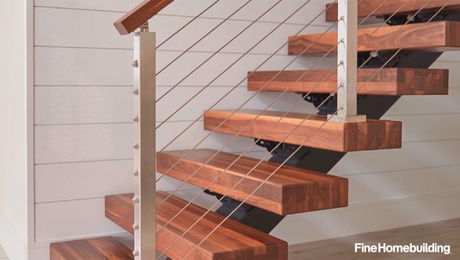I’m exploring ICF’s for use in my own home that we will be building this year. I don’t have any hard figures yet, but it seems that doing a standard 8″ poured wall and applying rigid foam insulation myself would be more cost effective. Any reason this wouldn’t work just as well as ICF’s? Also, if I were to insulate only one side of the basement wall which side – interior or exterior would be more effective ( assuming the loss of interior space was not a problem)? Does anyone know the R value of a 8″ poured wall, just the concrete? Thanks
Discussion Forum
Discussion Forum
Up Next
Video Shorts
Featured Story

The "She Build" initiative is empowering women in Seattle, WA by ensuring they have safe, healthy homes.
Featured Video
Builder’s Advocate: An Interview With ViewrailHighlights
"I have learned so much thanks to the searchable articles on the FHB website. I can confidently say that I expect to be a life-long subscriber." - M.K.

















Replies
http://forums.prospero.com/n/mb/message.asp?webtag=tp-breaktime&msg=53655.1&search=y
Just the concrete is good for R=0.64. The R value of an 8" poured concrete wall that is below grade has a total effective R value of 2.0, because of the surface effects.
Insulation in a place where it will not be subject to physical damage is far better than in place where it can be damaged. Exposed insulation on the exterior of a foundation wall looks pretty cheesey in most cases. Inside it can be concealed withing a furred wall or the like.
What do you mean by "surface effects"? I can deal with the exposed insulation on ext. with stone or such. Someone else said they thought by insulating the ext. only that the mass of the wall would act as a heat sink for the int. Any thoughts on this? I'm not leaning one way or the other yet, insulating the inside would definitely be easier.
"Someone else said they thought by insulating the ext. only that the mass of the wall would act as a heat sink for the int. Any thoughts on this? I'm not leaning one way or the other yet, insulating the inside would definitely be easier."I don't know how much of a heat sink you get out of it... If any of the real pros here can't tell you, you might find something at http://www.onrl.gov/sci/roofs+walls. They do alot of talking about building envelopes and thermal mass etc... The major difference for my basement (inside insulation or outside) is that if I insulate inside I expose my limestone rubble foundation to more freeze/thaw cycles (owen sound, ontario, canada). In my neck of the woods it is recommended that you not insulate this kind of foundation on the interior more than 2' below grade. It is assumed that the above grade portion will be able to dry out sufficiently that the temperature fluctuations won't hurt the wall to much.I suspect from the reading I have done various places (here, and the rest is mostly research papers) that a modern foundation does not have this kind of problem.My house is 100 years old... Ever since I got interested in the way the place was put together I discovered that my new hobby of fixing the place up will never never stop...
Great site! The link you gave me had a typo though. It's http://www.ornl.gov/sci/roofs+walls. I'm not an engineer and don't pretend to understand all the technical data. It seems the results of their testing indicate that insulating the exterior of a concrete wall and leaving the mass exposed to the inside gives better performance than either icf's or interior only insulations. The differences in performance also appear to be greater in a desert climate than in my area (Michigan). If I can build my basement more economically with a poured wall and insulation on the exterior only,( as opposed to icf's ) that will be the route I take.
This is another site with a lot of "cold weather" articles on the same sort of thing. It is the Canadian National Research Council's construction research site. If you liked the ONRL site you might like this too.http://irc.nrc-cnrc.gc.ca/irccontents.htmlLast year I didn't know what any of this stuff meant.
When you calculate the total heat transfer in any actual process, whether it be for an insulated steam pipe or a building wall, the R value of the components are only part of the equation. As heat travels through a series of different media, such as in the case of a wall it goes from the warm, relatively still, inside air to the surface of the wall to the wall material to the cold surface and then to the cold, usually moving, outside air. The surface effect of a vertical inside surface is and equivalent R value of about 0.68 . The surface effect of a horizontal inside surface (ceilings only, floors are different) is about 0.64 . The surface effect of the outside of a wall or roof exposed to a 15 mph wind (which is typical design conditions in a lot of the county) is 0.17. The outer surface of the wall below grade is treated as if it were an inside surface. So for the 8" poured concrete wall below grade you get 0.68 + 0.64 + 0.68 = 2.0.
Whoever posted that junk about the wall's thermal mass and the bit about the heat sink, doesn't understand the basic heat transfer concept described above. The mass of the wall will be unaffected by which side you add insulation. Its like saying you truck will be more efficient if you load the right side more because that the way it leans when I step on the gas. Based on a whole lot of practical factors, I would insulate the inside of the wall in most cases, especially where concrete and/or masonry are involved.
>> The mass of the wall will be unaffected by which side you add insulation.
That's strictly true, and in a steady state situation, the heat transfer throught the wall is also unaffected by which side you add insulation. But if the internal and external temperatures vary, as they do in the real world, the overall thermal performance of the wall is affected by which side the insulation is on. Every study I've ever seen says that if you have significant mass in the wall, then the performance is better if the mass in inside the insulation envelope.
" Every study I've ever seen says that if you have significant mass in the wall, then the performance is better if the mass in inside the insulation envelope."And it depends on the amount of daily cycling.One study I saw showed only minor improvment in climatements like Miami or Mineapolis, minor in the middle of the country. And very larg in high desert areas where it will go from very high during the day and very cool at night.So this is really only effective for that part of the foundation that is exposed to daily tempature cycling.
You'll have to point me to a published study so that I can understand the details of what is meant by "thermal performance". To a mechanical engineer, it is a BS term. If it is to mean the resistence to heat transfer, then I beleive that you have misunderstood the "study". If it means something else, it is a BS term and the author of such a study is not credible. I will read what there is and see what they did and how they characterized the results.
I suspect that what they are trying to convey, and that you misquoted, is that the temperature in the space with more mass inside the envelope is more stable (less easily changed) that the opposite. I would agree with that.
"....that if you have significant mass in the wall, then the performance is better if the mass in inside the insulation envelope..."
This statement leads me to believe that don't fully understand. If you have significant mass in the wall, which is the envelope, then what you said is inaccurate.
http://hem.dis.anl.gov/eehem/99/990912.htmlUntil now, however, calculating the thermal performance of high-mass walls has been difficult. The steady-state R-value traditionally used to measure the thermal performance of a wall does not accurately reflect the dynamic thermal performance of massive building envelope systems. Whole-building energy simulations for buildings containing massive wall systems are similarly problematic. For example, DOE-2 uses a one-dimensional calculation engine, which is inaccurate in simulations of complex building envelope assemblies. To enable these computer models to perform whole-building energy simulations, simplified one-dimensional descriptions of complex walls have to be developed for complex building envelope assemblies. Currently, the standard modeling process is to replace complex material configurations by one-dimensional multilayer structures with similar R-values and similar material arrangements. Unfortunately, such simplifications cannot accurately represent the complicated two- and three-dimensional dynamic heat transfer that can be observed in most massive-wall assemblies.To show the benefit of these assemblies, thermal-performance analysis must properly reflect the effects of thermal insulation and mass distribution inside the wall. Application of the recently developed equivalent-wall theory led to the development of a new analytical matrix of a high-mass wall's energy performance. We are calling it dynamic benefit for massive systems (DBMS). The thermal mass benefit is a function of the material configuration, building type, and climate conditions, since high-mass walls are of greatest benefit in climates with large diurnal swings in temperature.DBMS values are obtained by comparing the energy performance of a one-story ranch house built with lightweight wood frame walls to the energy performance of the same house built with exterior massive walls. The product of DBMS and steady-state R-value is called an R-value equivalent for massive systems. This R-value equivalent does not have a physical meaning. It should be understood only as an answer to the question "What wall R-value should a house with wood frame walls have to obtain the same space-heating and -cooling loads as a similar house containing massive walls?"We analyzed the dynamic thermal performances of more than 20 multilayer and homogenous wall material configurations using thermal-performance comparisons of massive walls and lightweight wood frame walls. A one-story ranch house was used for these comparisons, which we performed using DOE-2.1E, a whole-building energy computer code.The evaluation of the dynamic thermal performance of these massive wall systems combined experimental and theoretical analysis. The theoretical analysis was based on dynamic three-dimensional finite difference simulations and whole-building energy computer modeling. Dynamic hot-box tests served to calibrate the computer models, and to estimate the steady-state R-value and the dynamic characteristics of the wall (see "General Procedures").
Bill,
This is being treated as if it were some new concept. Large buildings have been built from big pieces of rock, and brick and concrete longer than we've been alive. These same buidlings have been successfully heated and cooled, by people in my profession, also longer than I've been alive. I learned the HVAC design trade from an older engineer who had been designing HVAC systems for over 35 years prior to my working for him (for the last 20 years) and he learned it from an elder, well experienced engineer in the HVAC design field who had been doing this for decades.
I have utilized the best commercial software on the market for load determination, I have seen the governmental attempts at appromating the same. I can guarantee you that either of these gentelmen from which I learned this trade or I could do an accurate anaylsis of the heat loss and/or gain through any wall of known materials with a calculator and a pencil. With that information, using the same complex technology (pencil & paper) properly size and select the proper heating and cooling equipments and terminal elements to comfortably and efficiently meet the ventilation and comfort requirements of the building. Beyond that end, all the rigamorole that you and your group claim to be "doing" is of no real benefit.
Is there one person in your group that has spent the better part of a lifetime analyzing, designing, installing, troubleshooting and perfecting HVAC and control systems? Anyone there represneting SMACNA or ASHRAE? Doesn't sound like it.
"The steady-state R-value traditionally used to measure the thermal performance of a wall does not accurately reflect the dynamic thermal performance of massive building envelope systems."
If you are trying to say that the physical properties of the materials of construction used in a wall somehow morph during transients, I don't buy it. The actual heat transfer through any transient process is obviously going to chage with time. These concepts are easily understood and long been incoporated into designs, where necessary, such as in design of Thermal Stoarge (ice tanks) systems.
To apply any of the engineering and analyis required for complex buildings and their system to the poured concrete basement wall in a residence is idiotic to an unfathomable degree. Simplicity is used where simplicity applies. Your group might to well to consider that concept.
Edited 2/11/2005 12:51 pm ET by Timbo
>> ... the temperature in the space with more mass inside the envelope is more stable (less
>> easily changed) tha[n] the opposite.
That was my understanding of what I read, and is what I was characterizing as better performance.
>> >> ... if you have significant mass in the wall ...
>> This statement leads me to believe that don't fully understand.
I'm pretty sure I don't fully understand. :) I should have said "significant mass as a part of a wall system." For example, consider a thin shell concrete domes, a few inches of sprayed concrete and several inches of sprayed polyurethane foam. The way I was using the terms, the concrete is the significant mass and could be inside or outside the foam, which is the insulation envelope. The foam and the conrete together are the wall system. It wouldn't surprise me at all to find out that I'm misusing the industry standard vocabulary.
Scamp, here's a piece of a previous thread, same topic. Cloud did some digging and came up with what was already clear to me. I live in a (non-dome) house where the concrete shell, and the dirt around it, are my heating/cooling system. Certainly don't want insulation between interior air and my storage medium, either winter or summer. For my exposed walls I used copper sheathing. Works extremely well.
Same paper, it's in the details of the paper and the charts (chart 5, for example).
For example, here's from the summary:
"Comparative analysis of sixteen different material configurations showed that the most effective wall assembly was the wall with thermal mass (concrete) applied in good contact with the interior of the building. Walls where the insulation material was concentrated on the interior side, performed much worse. Wall configurations with the concrete wall core and insulation placed on both sides of the wall performed slightly better [than interior insulation only], however, their performance was significantly worse than walls containing foam core and concrete shells on both sides."
The best config is to put the insulation outside of the thermal mass. Not for nothing, but that's the exact config of the domes I design, and their low energy use comes from that much more than from any "domeness".
PAHS Designer/Builder- Bury it!